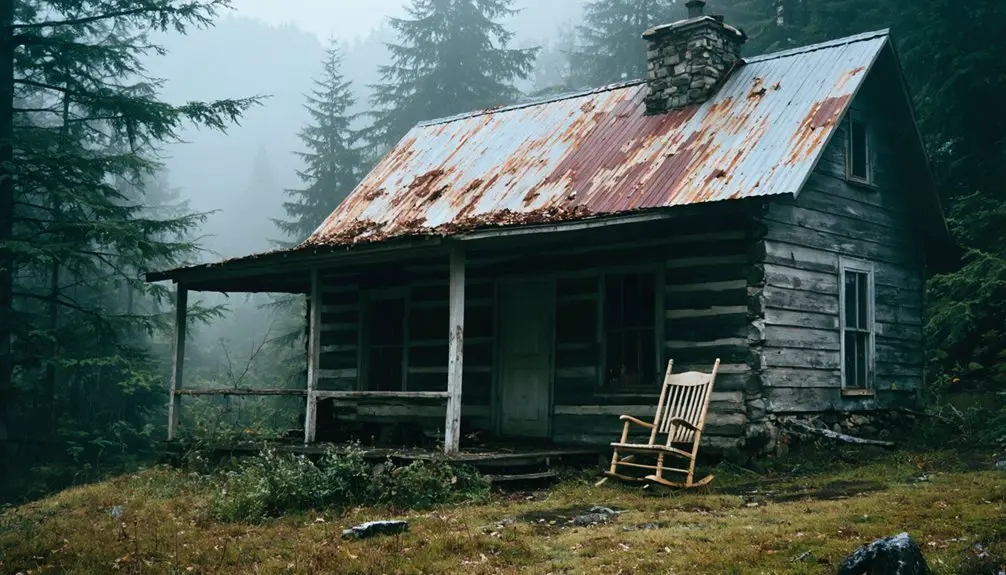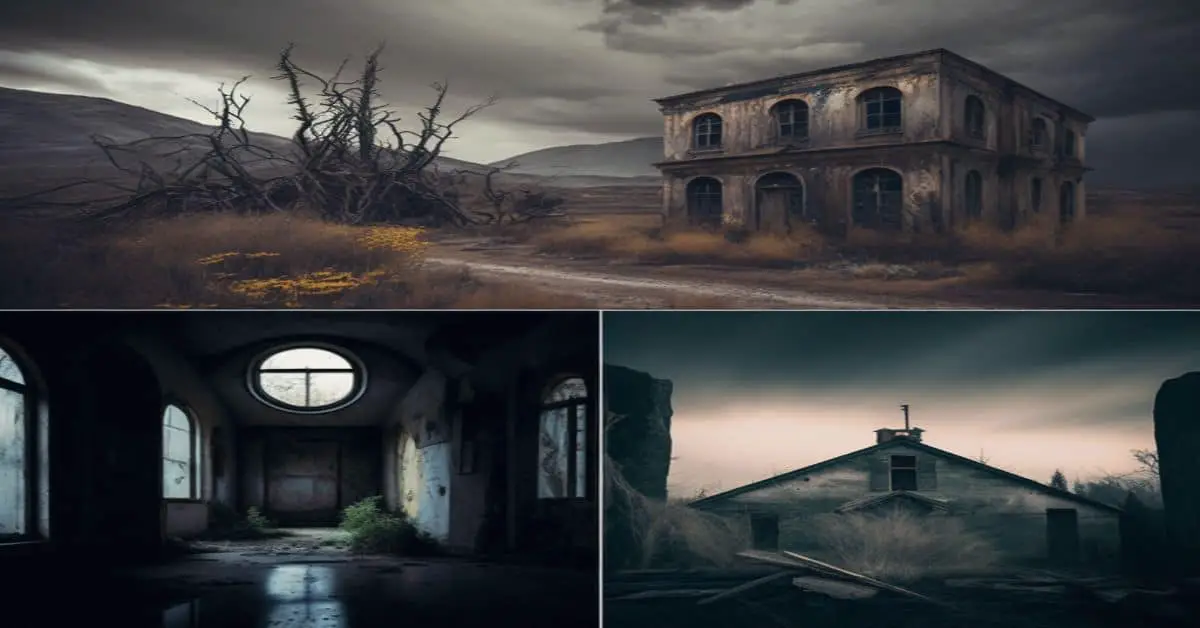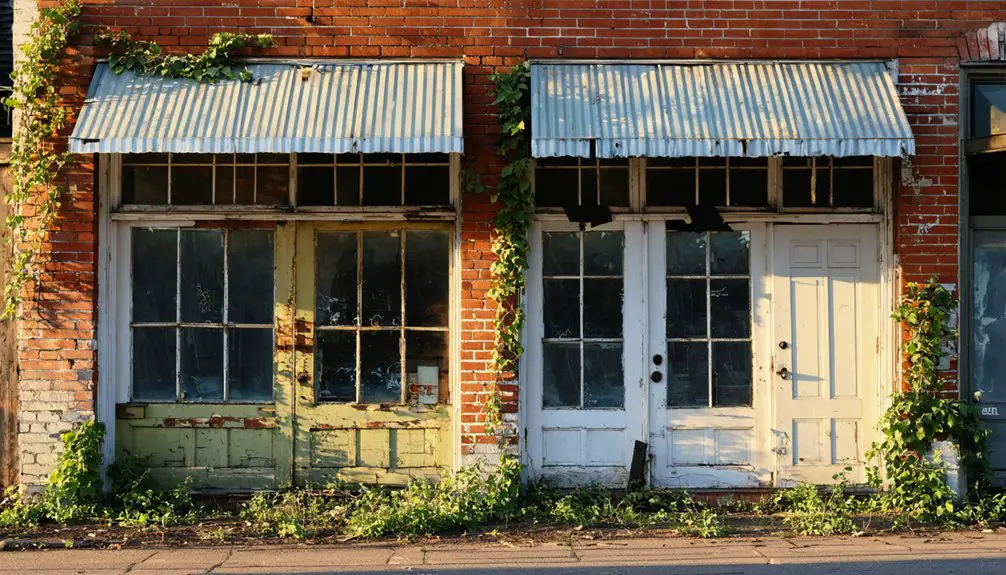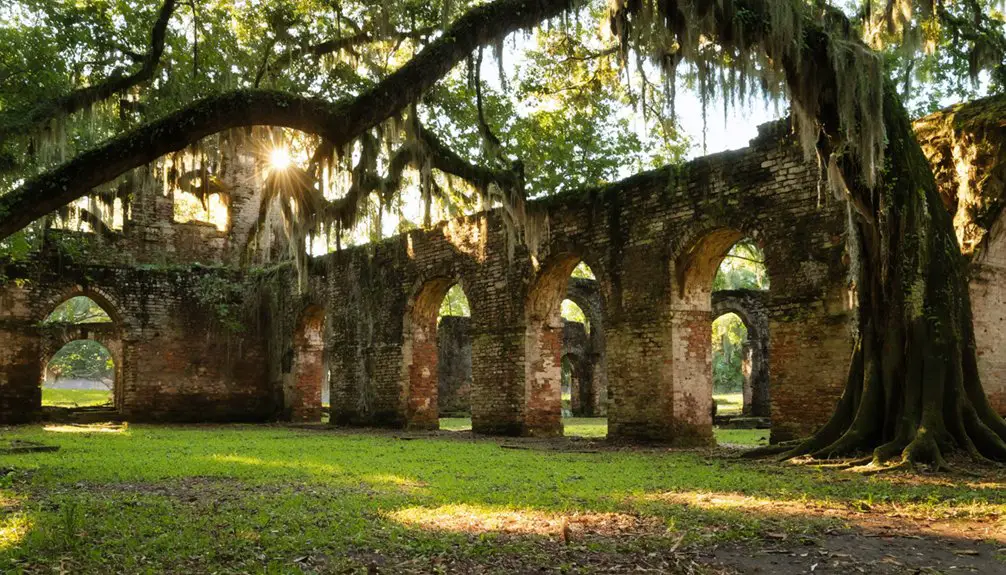You’ll discover Cataloochee Valley as a haunting ghost town within North Carolina’s Great Smoky Mountains, where over 750 residents once thrived until their displacement in the 1930s for the national park’s creation. The valley preserves nine historic structures from the early 1900s, including the Palmer House and Caldwell House, showcasing pioneer Appalachian architecture. Today, you can explore original settler paths while possibly encountering the valley’s reintroduced elk herd amid its rich mountain heritage.
Key Takeaways
- Cataloochee Valley was forcibly abandoned when Great Smoky Mountains National Park was established, displacing over 750 residents from their homes.
- Nine preserved historic structures remain, including the Palmer House, Caldwell House, and Little Cataloochee Church, showcasing early 20th-century Appalachian architecture.
- The valley peaked at 1,200 residents in 1910, with families sustaining themselves through farming, livestock, and seasonal fruit picking.
- Former residents and descendants maintain connections through annual reunions and preservation efforts, keeping the valley’s history alive.
- Self-guided tours allow visitors to explore historic trails and buildings used by settlers from 1780 to 1816.
The Rise of a Mountain Community
When white settlers first ventured into the Cataloochee Valley in the 1840s, they discovered an ideal location for establishing a thriving mountain community.
You’ll find that pioneering families like the Palmers, Hannahs, Caldwells, and Bennets laid the foundation for remarkable community growth, establishing homesteads throughout the 1850s. The Cataloochee Turnpike construction from 1854-1856 helped facilitate vital transportation and connectivity for the growing settlement.
The valley’s economic development flourished as settlers capitalized on the fertile bottomlands and grassy balds. They raised livestock, including cattle, sheep, hogs, and turkeys, while supplementing their income through hunting and farming. The population grew substantially, reaching 764 residents by 1900.
Daily Life in the Appalachian Valley
Throughout the late 19th century, life in Cataloochee Valley centered around a complex web of subsistence farming, trade networks, and domestic production.
You’d find families growing corn, beans, and squash while raising livestock and tending gardens. They’d preserve food through traditional methods and convert excess corn into easily transportable whiskey. Like the ancient Woodland culture tribes before them, they relied heavily on these staple crops for survival.
The community barter system thrived, with local merchants extending credit for produce, handmade goods, and moonshine. The valley’s narrow dirt roads made travel and trade between neighboring communities challenging but necessary.
You’d see families weaving textiles, making molasses from cane, and collecting wild plants and game to supplement their food supplies. Extended families would work together on labor-intensive tasks like cane harvesting, while seasonal fruit picking provided additional income.
These traditional mountain ways formed the backbone of daily survival, with skills passed down through generations.
Historic Buildings and Architecture
The historic structures of Cataloochee Valley stand as architectural treasures from the late 19th and early 20th centuries.
You’ll discover the Palmer House‘s unique “dog-trot” design, featuring two cabins connected by an open passage, and the Caldwell House‘s innovative use of newspapers for insulation. The area’s historic architecture includes the 1889 Little Cataloochee Church with its original furnishings and functioning bell. The Will Messer communal applehouse remnants are still visible today, showcasing the valley’s agricultural heritage.
Each building showcases distinct preservation techniques. The historic Beech Grove School holds special significance as it hosted sessions Monday through Thursday from 8 AM to 4 PM.
The Cook Cabin, restored in 1999, exemplifies pioneer-era log construction with its rare brick chimney. Local materials, like hand-sawn yellow poplar boards, were used extensively in the Caldwell House.
While some structures remain unfurnished to prevent vandalism, you can freely explore these buildings, including the Palmer House’s exhibits on settler life and the church’s adjacent cemetery.
From Cherokee Land to Pioneer Settlement
Before European settlers arrived, you would’ve found Cherokee hunters using an extensive network of trails through Cataloochee Valley, with the main path connecting their Middle settlements to Overhill towns.
You’ll notice the valley’s name itself reflects this heritage, deriving from the Cherokee word *Gadalutsi*, meaning “fringe standing erect” – a reference to the tall trees along the ridgelines.
The valley’s population slowly grew to support a thriving community of over 750 residents by the early 1900s.
The first documented Euro-American presence came through Henry Caldwell’s land purchase, establishing livestock herding operations that would transform the valley’s use from Cherokee hunting grounds to pioneer farmland. The Treaty of Holston in 1791 had formally opened the area for settlement by forcing the Cherokee to give up their claims to the valley.
Early Cherokee Trade Routes
Ancient animal paths seeking food, water, and salt deposits laid the foundation for an intricate network of Cherokee trade routes that would shape the economic and cultural landscape of the Southeast.
You’ll find that eighteen major trading paths crisscrossed what’s now North Carolina, with the Great Trading Path and Lower Cherokee Traders’ Path serving as essential arteries for commerce and cultural exchange.
These routes, spanning roughly 160 miles, connected Cherokee Lower Towns to Catawba villages and European settlements. By 1748, isolated settlers arrived with permission from the Cherokee tribes, marking the beginning of European colonization along these ancient pathways.
Along these paths, you’d see a steady flow of European manufactured goods – guns, jewelry, and blankets – heading to Cherokee villages, while deerskins and furs moved toward colonial markets. The Catawba people were especially known for trading their mica and animal skins for essential resources like fish and salt.
Tribes like the Saponi and Occaneechi maintained these routes, acting as significant middlemen in this extensive trade network.
Pioneer Settlement Challenges
While Cherokee traders had long mastered the region’s challenging terrain, pioneer settlers arriving in Cataloochee during the 1830s and 1840s faced formidable obstacles in establishing their homesteads.
The settler hardships included clearing dense forests, defending against wild predators, and traversing mountainous terrain with limited infrastructure. You’ll find that environmental adaptation was essential as pioneers transformed Cherokee hunting grounds into agricultural settlements.
- You’d need significant strength to clear the thick underbrush and establish farmland in the rugged landscape.
- You’d face threats from bears, panthers, and wolves that endangered both settlers and livestock.
- You’d have to master seasonal livestock drives to distant markets in Waynesville and Charleston for trading necessities.
The isolation demanded self-sufficiency, with settlers relying on hunting, trapping, and livestock raising while gradually building a thriving mountain community of over 1,200 residents by 1910.
Wildlife and Natural Surroundings
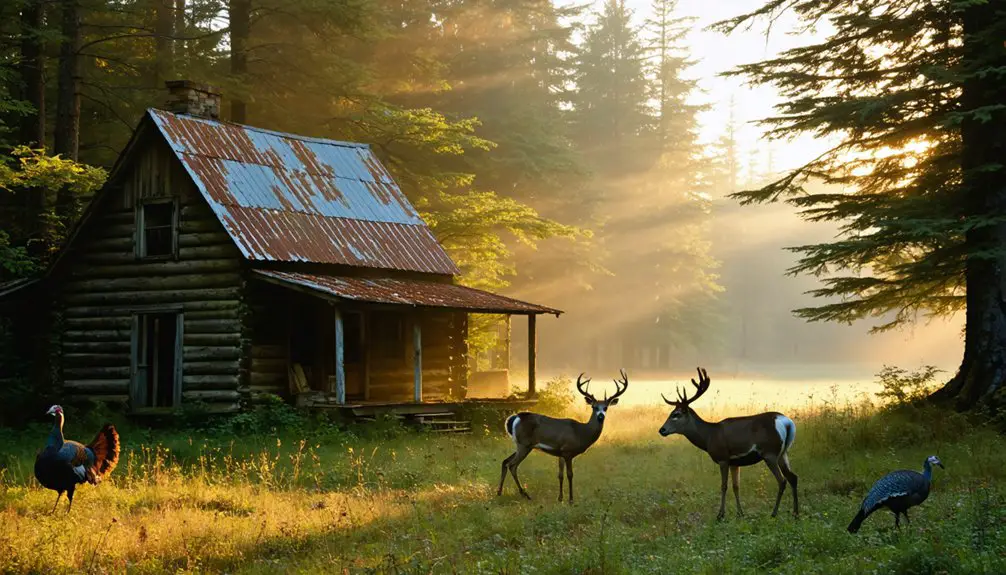
As you explore Cataloochee’s wilderness, you’ll notice evidence of ongoing predator-prey dynamics between black bears, bobcats, and the valley’s abundant elk and deer populations.
The natural resource wealth that first drew settlers continues today, with Cataloochee Creek supporting wild trout and the surrounding old-growth forests harboring diverse wildlife.
While these species generally maintain a natural balance, wildlife management agencies actively monitor predator populations to protect both livestock and the reintroduced elk herd.
Predator Conflicts and Control
Since the reintroduction of elk to Cataloochee Valley in 2001, the region’s predator-prey dynamics have evolved considerably.
You’ll find black bears, coyotes, bobcats, and mountain lions impacting wildlife populations, particularly elk calves. To maintain ecological balance, wildlife management agencies implement strategic control measures through collaborative monitoring and habitat enhancement.
- Prescribed burns and meadow creation improve forage quality while reducing predator ambush opportunities.
- Radio collars, GPS tracking, and DNA analysis help monitor predator impacts on elk populations.
- Regulated hunting frameworks, established through partnerships between NPS, NC Wildlife Resources Commission, and Cherokee Tribe, balance predator-prey numbers.
As elk range expands up to 45 miles from Cataloochee, predator dynamics shift accordingly.
Conservation partnerships protect critical habitat, while ongoing studies guide sustainable population management strategies.
Natural Resource Abundance
After its successful reintroduction in 2001, Cataloochee Valley’s wildlife population has flourished into a thriving ecosystem of diverse species.
You’ll find the elk herd has grown from 25 to over 150 animals, sharing their habitat with black bears, white-tailed deer, bobcats, and wild turkeys. The valley’s wildlife conservation efforts showcase nature’s resilience, with Cataloochee Creek supporting wild trout populations and native amphibians.
The surrounding 6,000-foot peaks create a protected corridor for ecosystem sustainability, though climate change poses new challenges.
You’ll witness this abundance of natural resources while hiking the Boogerman and Little Cataloochee trails, especially during dawn and dusk when elk are most active.
The valley’s complex food web demonstrates the delicate balance between predators, prey, and their shared environment.
The Great Displacement
When the Great Smoky Mountains National Park was established in the late 1920s, it set in motion a massive displacement that would forever change the Cataloochee Valley. Over 750 residents faced the loss of their ancestral homes through government acquisition and eminent domain. This displacement trauma stripped families of their cultural heritage, forcing them to abandon generations of mountain life during the harsh Great Depression era.
- Many families like the Hannahs fought legal battles to keep their land but ultimately lost through condemnation.
- Lifetime leases were granted to some, but park regulations made traditional farming and livestock grazing impossible.
- Former residents and their descendants continue to honor their connection through annual reunions and preservation efforts.
The shift transformed a thriving mountain community into protected parkland, leaving behind empty buildings as silent witnesses to this complex chapter of American progress and loss.
Preserving Mountain Heritage Today
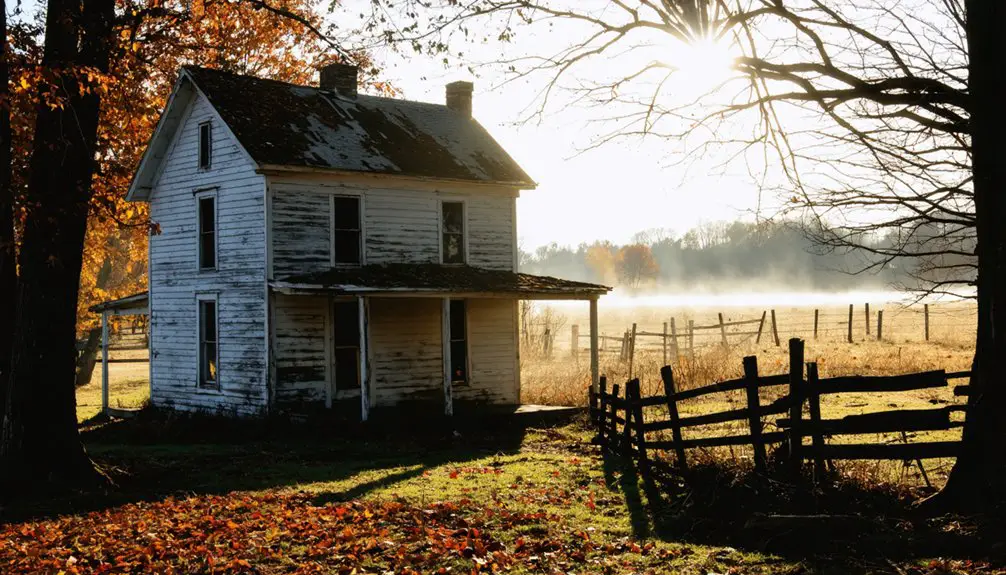
Today’s preservation efforts in Cataloochee Valley stand as a tribute to the resilient mountain heritage that once thrived there.
You’ll find nine historic structures, including the 1909 Caldwell House, showcasing authentic early 20th-century Appalachian architecture. These buildings tell the story of settlers who lived without modern conveniences until the 1930s.
Through heritage education programs and cultural events, you can explore these preserved frame buildings via designated hiking trails.
Experience mountain heritage firsthand by exploring historic frame buildings through guided trails, educational programs and cultural celebrations.
The valley’s isolation has helped maintain its original character, while conservation efforts protect both natural landscapes and historic sites. You’ll witness successful wildlife initiatives, like the elk reintroduction program started in 2001, alongside traditional mountain culture.
Descendants of original residents still return regularly, keeping their ancestral connections alive through annual gatherings and oral histories.
Walking Through Time: A Self-Guided Tour
Stepping onto Cataloochee’s historic trails offers visitors an immersive journey through Appalachian frontier life.
You’ll walk the same paths as Methodist circuit riders and early settlers used from 1780 to 1816, now preserved as the Cataloochee Trail (P-51). The route showcases mountain folklore through carefully preserved structures that tell stories of resilience and adaptation.
- Explore the Palmer House and Caldwell House (1906), featuring authentic period details like peeling wallpaper and vintage linoleum.
- Visit Palmer Chapel (1903) and Beech Grove schoolhouse (1901), cornerstones of historical preservation.
- Discover hidden details like newspaper insulation and Sears catalogs in cabin walls.
As you navigate this living museum, you’ll encounter evidence of frontier life, from livestock grazing paths to hunting grounds, while possibly spotting elk in their natural habitat.
Frequently Asked Questions
Are There Any Reports of Paranormal Activity in Cataloochee’s Abandoned Buildings?
You’ll find limited documented evidence of ghost sightings or eerie encounters in these buildings, though local folklore suggests paranormal activity exists. The historic atmosphere and isolation contribute to supernatural speculation.
Can Visitors Stay Overnight in or Near the Historic Cataloochee Buildings?
You can’t stay inside the historic buildings, but you’ll find camping options at designated park campgrounds and lodging availability at nearby Maggie Valley’s motels, cabins, and resorts within 3-5 miles.
What Happened to the Families Who Were Forced to Leave?
You’ll find the displaced families mostly moved to nearby towns like Waynesville or urban areas, facing economic hardships as they left their multi-generational mountain farming lifestyle behind. Their historical legacy lives on through preservation efforts.
Is It Possible to Access Cataloochee Valley During Winter Months?
You can access Cataloochee Valley in winter, but it’s challenging and unreliable. Winter road conditions often lead to closures of Cove Creek Road, and steep, unpaved sections become hazardous with snow and ice.
How Many Original Cataloochee Structures Have Been Lost to Time?
Patiently passing time has pilfered nearly 190 original structures from you. Out of 200+ buildings of historical significance, you’ll find only a handful remaining today – that’s roughly 95% lost forever.
References
- https://www.lilblueboo.com/2015/09/a-place-called-cataloochee.html
- https://en.wikipedia.org/wiki/Cataloochee_(Great_Smoky_Mountains)
- https://www.dncr.nc.gov/blog/2024/01/22/cataloochee-trail-p-50
- https://www.youtube.com/watch?v=hgQOIL-jLeY
- https://en.wikipedia.org/wiki/Ghost_Town_Village
- https://piddlin.com/library/smoky-mountains/cataloochee-valley-history
- https://smokymountainnews.com/archives/item/12214-the-cataloochee-exodus-story-of-picturesque-valley-s-transformation-captured-in-new-film
- https://www.npca.org/articles/2021-valley-of-memories
- http://www.mysmokymountainvacation.com/historicbuildings/cataloochee.html
- https://npshistory.com/publications/usfs/region/8/history/intro.htm
